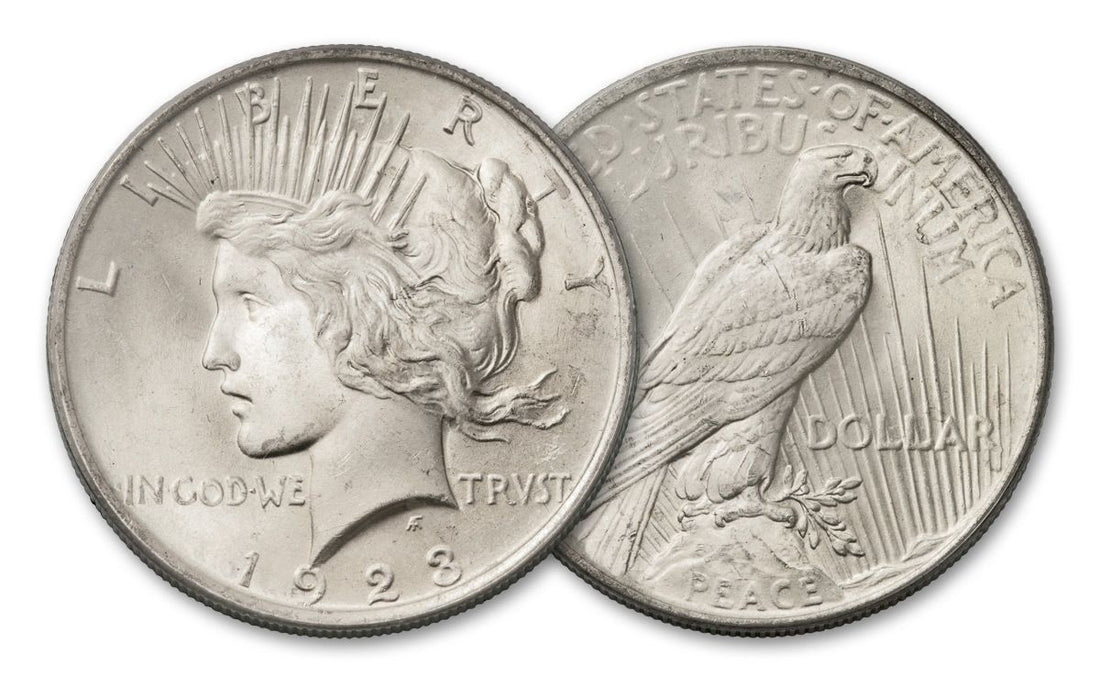To commemorate the end of World War I and to honor world peace, the United States created the first Peace Dollar in late December of 1921. This Silver Peace Dollar was produced intermittently from 1921 to 1928 and then again in 1934 and 1935 at three of the United States Mint facilities located in Denver, San Francisco, and Philadelphia. The mint marks on the Peace Dollar can be found on the reverse side of the coin located below the word ONE.
Designed by Anthony De Francisci in early 1921 a modern Art Deco Liberty Head with a crown of rays was depicted on the obverse and a bold majestic eagle at rest on a high mountain top, clutching the laurel wreath of Peach in his talons, on the reverse.
The Peace Silver Dollar is a popular coin among collectors, and an important part of US coin history. The Peace Dollar was the last dollar coin ever minted for circulation with a silver content of 90%. For this reason, many coin collectors cherish the Peace Dollar as the last genuine American silver dollar.
Of all the dollar coins ever produced by the mint, the Peace dollar is one of the most recognized and coveted. This coin's silver content, limited mintage and history make it sought after by collectors and coin enthusiasts alike.
A Coin With A Fascinating History
Initially this design was sculpted in high relief, but was minted in this style for only one year. This style relief caused difficulty in stacking at the Federal Reserve Banks and also shortened the life of the very expensive minting dies. The Peace Dollar is only the second coin in United States history to be struck in high relief. In 1922, George T. Morgan, then Chief Engraver of the United States Mint, made some significant changes without the knowledge of its designer. Morgan lowered the relief and flattened the concave fields thereby increasing the life of the dies and insuring easier mass production and storage.

Peace Dollar Design
The Peace Silver Dollar was designed by Anthony De Francisci. On the obverse side, the silver coin features a design of Lady Liberty, while the reverse of the Peace Dollar shows a proud image of a standing American eagle resting on top of a mountain watching the sunset.
Official specifications of Peace Silver Dollars
-
Content of 90% pure silver and 10% copper
-
Net silver weight of .77344 ounces
-
Diameter of 38.1 millimeters, about 1.5 inches.
-
Weighs 26.73 grams
-
Brilliant uncirculated condition
In God We Trvst?

Was there a mistake made? Actually, the Peace Dollar's inscription of the motto "In God We Trust" uses the Latin version in which the letter V is substituted for U. This was the grand design of De Francisci, and is just one of many details that set Peace Dollars apart from other coins from the US Mint.
True Scarcity
Peace silver dollars were minted following World War I,
t a time when the United States was in dire need of additional currency. As a result, most Peace silver dollars were placed directly into circulation. Most of today’s Peace silver dollars show evidence of regular use and have somewhat nominal value outside of their silver content highlighting the importance of separating rare dates, mints, and quality coins.
Furthermore, when silver hit $50 an ounce in 1980, hundreds of thousands of classic silver coins were sold to refiners and melted down for their silver content. The “Great Melting Pot” of 1980 dramatically decreased the known number of surviving Peace silver dollars and other classic coins.
Existing market supplies of Peace silver dollars are now lower than the original 190.5 million coins produced, and their value is likely only going to increase over time.
The Design
Congressional legislation introduced in May 1921 called this new coin the “peace dollar.” A July 1921 meeting of the Commission of Fine Arts suggested a closed competition of invited artists submit a design for a portrait of Liberty and to pay each sculptor $100 for their plaster models. President Harding’s presidential proclamation on Nov. 14, 1921, officially ended the war with Germany and on Nov. 19, eight artists were invited to submit designs by Dec. 12.
The designers were challenged to create an obverse depicting a Liberty head, “similar to that on the present coin, but made as beautiful and full of character as possible.” The artists were given more freedom to design the reverse, which was to be “left to the imagination of the artist, exercised within the limits of the coinage laws,” with the intention that the overall design be “decidedly American in spirit.”
The sculptor Anthony De Francisci based the obverse design of Liberty on the features of his wife, Teresa De Francisci. Due to the short length of the competition, he lacked the time to hire a model with the features he envisioned. Teresa De Francisci was born Teresa Cafarelli in Naples, Italy. In interviews, she related that when she was five years old and the steamer on which she and her family were immigrating passed the Statue of Liberty, she was fascinated by the statue, called her family over, and stuck a pose in imitation. She later wrote in a letter to her brother Rocco:
“You remember how I was always posing as Liberty, and how brokenhearted I was when some other little girl was selected to play the role in the patriotic exercises in school? I thought of those days often while sitting as a model for Tony’s design, and now seeing myself as Miss Liberty on the new coin, it seems like the realization of my fondest childhood dream.”


